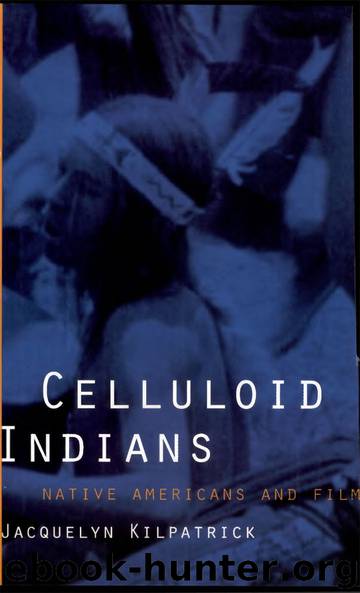Celluloid Indians: Native Americans and Film by Kilpatrick Neva Jacquelyn

Author:Kilpatrick, Neva Jacquelyn [Kilpatrick, Neva Jacquelyn]
Language: eng
Format: epub
ISBN: 9780803278387
Publisher: UNP - Bison Original
Published: 2016-02-29T21:00:00+00:00
1492: Conquest of Paradise (1992)
1992 was the quincentennial of Columbus’s “discovery” of the Americas, and Hollywood jumped on the revisionist bandwagon with two major films and numerous television specials on Columbus the hero or Columbus the villain. None of these were particularly successful, possibly because American audiences seemed unwilling to accept Columbus as either hero or villain. Although the concept of Columbus as hero is deeply entrenched in American mythology, by 1992 it was a well-publicized fact that the Taino Indians, who numbered in the millions when he arrived, had ceased to exist within a very few years due to forced labor, starvation, disease, slavery, and slaughter.31 That knowledge has made it difficult for American viewers trying to be “politically correct” to accept Columbus as a film hero. Judging by box office receipts, most viewers in 1992 apparently chose simply not to deal with him at all.
Ridley Scott’s 1492: Conquest of Paradise is possibly the most revisionist of the productions. The directing in this film is excellent in flashes, with incredibly beautiful scenes of the little fleet at sea, the island breaking through the mist, frightening Inquisition burnings, and lavish court scenes. Although the pacing is generally tedious, an unusual problem for the director of such action films as Blade Runner (1982) and Thelma and Louise (1991), the rich texture of the film almost overcomes that flaw. The acting is also of top quality. Gérard Depardieu as Columbus (with a French accent?), Armand Asante as his nemesis, Sanchez (a conflation of King Ferdinand and Torquemada), and Sigourney Weaver as Queen Isabel bring immense talent and believability to their roles. The other supporting actors are also excellent, so the failure of the film does not lie in the talent assembled. The problem is that Scott tries to walk a razor’s edge between depicting the national myth and revising that myth. The result is that no one is particularly pleased.
In his article, “Cinema’s Conquistadors,” Peter Wollen places the films about Columbus, particularly Scott’s, in the realm of the western genre. He believes that at the “heart of Hollywood lay the myth of the West, the evocation of a world in which ‘knights of the true cause’ were set against the forces of evil and ‘pagan savagery’ represented by the Indian.” He refers to a 1955 essay by Eric Rohmer, who saw the depiction of the American hero and the American West as the act of inventing a tradition—in short, constructing a myth. “[T]he classical elegance and efficacy of the American cinema came precisely from the historic role of the Americans as a colonising people like the Ancient Greeks, …there was a clear parallel ‘between the first colonisers of the Mediterranean and the pioneers of Arizona.’ Typical American heroes are members of ‘a race of conquerors, which opens up the land, founds cities, is in love with action and adventure, and in spite of or perhaps because of this is more determined to preserve its religious or moral tradition.’ ”32
Columbus not only fits
Download
This site does not store any files on its server. We only index and link to content provided by other sites. Please contact the content providers to delete copyright contents if any and email us, we'll remove relevant links or contents immediately.
| Coloring Books for Grown-Ups | Humor |
| Movies | Performing Arts |
| Pop Culture | Puzzles & Games |
| Radio | Sheet Music & Scores |
| Television | Trivia & Fun Facts |
The Kite Runner by Khaled Hosseini(5085)
Gerald's Game by Stephen King(4584)
Dialogue by Robert McKee(4323)
The Perils of Being Moderately Famous by Soha Ali Khan(4169)
The 101 Dalmatians by Dodie Smith(3454)
Story: Substance, Structure, Style and the Principles of Screenwriting by Robert McKee(3397)
The Pixar Touch by David A. Price(3366)
Confessions of a Video Vixen by Karrine Steffans(3246)
How Music Works by David Byrne(3187)
Fantastic Beasts: The Crimes of Grindelwald by J. K. Rowling(2995)
Harry Potter 4 - Harry Potter and The Goblet of Fire by J.K.Rowling(2990)
Slugfest by Reed Tucker(2942)
The Mental Game of Writing: How to Overcome Obstacles, Stay Creative and Productive, and Free Your Mind for Success by James Scott Bell(2845)
4 - Harry Potter and the Goblet of Fire by J.K. Rowling(2657)
Screenplay: The Foundations of Screenwriting by Syd Field(2576)
The Complete H. P. Lovecraft Reader by H.P. Lovecraft(2514)
Scandals of Classic Hollywood: Sex, Deviance, and Drama from the Golden Age of American Cinema by Anne Helen Petersen(2465)
Wildflower by Drew Barrymore(2445)
Robin by Dave Itzkoff(2386)
